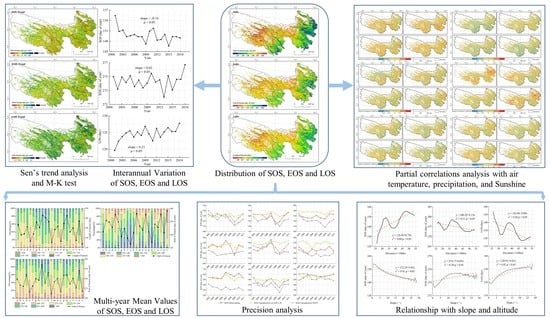LAI-Based Phenological Changes and Climate Sensitivity Analysis in the Three-River Headwaters Region
Abstract
:1. Introduction
2. Materials and Methods
2.1. Overview of the Study Area
2.2. Data Source and Preprocessing
2.2.1. Remote Sensing Data
2.2.2. Meteorological Data
2.2.3. Elevation Data
2.3. Study Methods
2.3.1. Extraction Methods of Vegetation Phenology
- (1)
- Time series reconstruction
- (2)
- Phenological extraction
- (3)
- Evaluation index
2.3.2. Sen’s Trend Analysis
2.3.3. Mann–Kendall Test
2.3.4. Partial Correlations Analysis
2.3.5. Sensitivity Analysis
3. Results
3.1. Extraction Results of Phenological Data
3.2. Temporal and Spatial Variation Trend of Vegetation Phenology
3.3. Precision Analysis
3.4. Relationship between Vegetation Phenology and Topography
3.4.1. Relationship between Vegetation Phenology and Altitude
3.4.2. Relationship between Vegetation Phenology and Slope
3.5. Relationship between Vegetation Phenology and Meteorological Factors
3.5.1. Relationship between SOS of Vegetation and Meteorological Factors
3.5.2. Relationship between EOS of Vegetation and Meteorological Factors
4. Discussion
4.1. Comparative Analysis of Phenological Research Methods
4.2. Analysis of Influencing Factors
4.3. Uncertainty Analysis
5. Conclusions
- (1)
- The phenological data of the vegetation in the Three-River headwaters region can be better extracted by using the A-G fitting method and maximum slope method. Compared with the NDVI, the precision of the vegetation phenology extracted based on the GLASS LAI is higher. The SOS of the vegetation in the Three-River headwaters region is mainly concentrated in May, showing a trend of gradually decreasing from the northwest to southeast in space; the EOS of the vegetation is mainly concentrated in a period from early October to mid-October, showing a trend of gradually increasing from the northwest to Southeast in space and the LOS of the vegetation is between about 115 and 165 days, showing a trend of gradually extending from the northwest to southeast in space. In the Three-River headwaters region, the SOS of the vegetation in the southeast is earlier than that in the northwest; the EOS of the vegetation in the southeast is later than that in the northwest and the LOS of the vegetation in the southeast is longer than that in the northwest. With the increase in altitude, the SOS of the vegetation is delayed, the EOS of the vegetation is advanced and the LOS of the vegetation is shortened. With the increase of the slope, the SOS of the vegetation is advanced, and the EOS of the vegetation is delayed, resulting in a longer LOS.
- (2)
- The vegetation SOS has a stronger correlation with the air temperature than with the precipitation or sunshine duration. In particular, the SOS of the vegetation has the strongest correlation with the average temperature in the period from March to May. In terms of the spatial distribution, except the northeast, most of the other regions are negatively correlated. The average temperature in this period showed an upward trend in the last 18 years, which may result in the vegetation SOS starting earlier and earlier over time. Compared with the air temperature and precipitation, the EOS of the vegetation has a stronger correlation with the sunshine duration, particularly during October. However, the cumulative sunshine duration in October has shown a downward trend in the past 18 years, and this may have contributed to the EOS of the vegetation not changing, even though the SOS changed.
Author Contributions
Funding
Data Availability Statement
Conflicts of Interest
References
- White, M.A.; de Beurs, K.M.; Didan, K.; Inouye, D.W.; Richardson, A.D.; Jensen, O.P.; O’Keefe, J.; Zhang, G.; Nemani, R.R.; van Leeuwen, W.J.D.; et al. Intercomparison, interpretation, and assessment of spring phenology in North America estimated from remote sensing for 1982–2006. Glob. Chang. Biol. 2009, 15, 2335–2359. [Google Scholar] [CrossRef]
- Wu, L.; Ma, X.; Dou, X.; Zhu, J.; Zhao, C. Impacts of climate change on vegetation phenology and net primary productivity in arid Central Asia. Sci. Total Environ. 2021, 796, 149055. [Google Scholar] [CrossRef] [PubMed]
- Zhang, Q.; Kong, D.; Shi, P.; Singh, V.P.; Sun, P. Vegetation phenology on the Qinghai-Tibetan Plateau and its response to climate change (1982–2013). Agric. For. Meteorol. 2018, 248, 408–417. [Google Scholar] [CrossRef]
- Zhu, W.; Tian, H.; Xu, X.; Pan, Y.; Chen, G.; Lin, W. Extension of the growing season due to delayed autumn over mid and high latitudes in North America during 1982–2006. Glob. Ecol. Biogeogr. 2012, 21, 260–271. [Google Scholar] [CrossRef]
- Wang, S.; Yang, B.; Yang, Q.; Lu, L.; Wang, X.; Peng, Y. Temporal Trends and Spatial Variability of Vegetation Phenology over the Northern Hemisphere during 1982–2012. PLoS ONE 2016, 11, e0157134. [Google Scholar] [CrossRef] [PubMed]
- PetersLidard, C.D.; Zion, M.S.; Wood, E.F. A soil-vegetation-atmosphere transfer scheme for modeling spatially variable water and energy balance processes. J. Geophys. Res. Atmos. 1997, 102, 4303–4324. [Google Scholar] [CrossRef]
- Root, T.L.; Price, J.T.; Hall, K.R.; Schneider, S.H.; Rosenzweig, C.; Pounds, J.A. Fingerprints of global warming on wild animals and plants. Nature 2003, 421, 57–60. [Google Scholar] [CrossRef]
- Chen, X.Q.; Hu, B.; Yu, R. Spatial and temporal variation of phenological growing season and climate change impacts in temperate eastern China. Glob. Chang. Biol. 2005, 11, 1118–1130. [Google Scholar] [CrossRef]
- Deng, M.; Meng, X.; Lu, Y.; Li, Z.; Zhao, L.; Niu, H.; Chen, H.; Shang, L.; Wang, S.; Sheng, D. The Response of Vegetation to Regional Climate Change on the Tibetan Plateau Based on Remote Sensing Products and the Dynamic Global Vegetation Model. Remote Sens. 2022, 14, 3337. [Google Scholar] [CrossRef]
- Helman, D. Land surface phenology: What do we really ‘see’ from space? Sci. Total Environ. 2018, 618, 665–673. [Google Scholar] [CrossRef]
- Zheng, C.; Tang, X.; Gu, Q.; Wang, T.; Wei, J.; Song, L.; Ma, M. Climatic anomaly and its impact on vegetation phenology, carbon sequestration and water-use efficiency at a humid temperate forest. J. Hydrol. 2018, 565, 150–159. [Google Scholar] [CrossRef]
- Crimmins, T.M.; Crimmins, M.A.; Bertelsen, C.D. Complex responses to climate drivers in onset of spring flowering across a semi-arid elevation gradient. J. Ecol. 2010, 98, 1042–1051. [Google Scholar] [CrossRef]
- Doussoulin-Guzman, M.-A.; Perez-Porras, F.-J.; Trivino-Tarradas, P.; Rios-Mesa, A.-F.; Garcia-Ferrer Porras, A.; Mesas-Carrascosa, F.-J. Grassland Phenology Response to Climate Conditions in Biobio, Chile from 2001 to 2020. Remote Sens. 2022, 14, 475. [Google Scholar] [CrossRef]
- Wu, C.; Peng, D.; Soudani, K.; Siebicke, L.; Gough, C.M.; Arain, M.A.; Bohrer, G.; Lafleur, P.M.; Peichl, M.; Gonsamo, A.; et al. Land surface phenology derived from normalized difference vegetation index (NDVI) at global FLUXNET sites. Agric. For. Meteorol. 2017, 233, 171–182. [Google Scholar] [CrossRef]
- Duarte, L.; Teodoro, A.C.; Monteiro, A.T.; Cunha, M.; Goncalves, H. QPhenoMetrics: An open source software application to assess vegetation phenology metrics. Comput. Electron. Agric. 2018, 148, 82–94. [Google Scholar] [CrossRef]
- Meroni, M.; Rossini, M.; Guanter, L.; Alonso, L.; Rascher, U.; Colombo, R.; Moreno, J. Remote sensing of solar-induced chlorophyll fluorescence: Review of methods and applications. Remote Sens. Environ. 2009, 113, 2037–2051. [Google Scholar] [CrossRef]
- Kang, S.Y.; Running, S.W.; Lim, J.H.; Zhao, M.S.; Park, C.R.; Loehman, R. A regional phenology model for detecting onset of greenness in temperate mixed forests, Korea: An application of MODIS leaf area index. Remote Sens. Environ. 2003, 86, 232–242. [Google Scholar] [CrossRef]
- Chen, J.; Jonsson, P.; Tamura, M.; Gu, Z.H.; Matsushita, B.; Eklundh, L. A simple method for reconstructing a high-quality NDVI time-series data set based on the Savitzky-Golay filter. Remote Sens. Environ. 2004, 91, 332–344. [Google Scholar] [CrossRef]
- Hird, J.N.; McDermid, G.J. Noise reduction of NDVI time series: An empirical comparison of selected techniques. Remote Sens. Environ. 2009, 113, 248–258. [Google Scholar] [CrossRef]
- Roerink, G.J.; Menenti, M.; Verhoef, W. Reconstructing cloudfree NDVI composites using Fourier analysis of time series. Int. J. Remote Sens. 2000, 21, 1911–1917. [Google Scholar] [CrossRef]
- Pitas, I.; Karasaridis, A. Multichannel transforms for signal/image processing. IEEE Trans. Image Process. 1996, 5, 1402–1413. [Google Scholar] [CrossRef] [PubMed]
- Jonsson, P.; Eklundh, L. Seasonality extraction by function fitting to time-series of satellite sensor data. IEEE Trans. Geosci. Remote Sens. 2002, 40, 1824–1832. [Google Scholar] [CrossRef]
- Beck, P.S.A.; Atzberger, C.; Høgda, K.A.; Johansen, B.; Skidmore, A.K. Improved monitoring of vegetation dynamics at very high latitudes: A new method using MODIS NDVI. Remote Sens. Environ. 2006, 100, 321–334. [Google Scholar] [CrossRef]
- Julien, Y.; Sobrino, J.A. Global land surface phenology trends from GIMMS database. Int. J. Remote Sens. 2009, 30, 3495–3513. [Google Scholar] [CrossRef] [Green Version]
- Song, C.Q.; Ke, L.H.; You, S.C.; Liu, G.H.; Zhong, X.K. Comparison of Three NDVI Time-series Fitting Methods based on TIMESAT-Taking the Grassland in Northern Tibet as Case. Remote Sens. Technol. Appl. 2011, 26, 147–155. [Google Scholar]
- Ding, X.; Wang, C.Y. The Extraction of Regional Phonological Information Based on MODIS Time Series Vegetation Index. Geomat. Spat. Inf. Technol. 2015, 38, 85–87+91. [Google Scholar]
- Piao, S.L.; Liu, Q.; Chen, A.P.; Janssens, I.A.; Fu, Y.; Dai, J.; Liu, L.; Lian, X.; Shen, M.; Zhu, X. Plant phenology and global climate change: Current progresses and challenges. Glob. Chang. Biol. 2019, 25, 1922–1940. [Google Scholar] [CrossRef]
- Fischer, A. A model for the seasonal variations of vegetation indices in coarse resolution data and its inversion to extract crop parameters. Remote Sens. Environ. 1994, 48, 220–230. [Google Scholar] [CrossRef]
- Zhang, J. Comparative Study on Land Surface Phenological Parameters and Its Climate Responses Retrieved from Different Data Sources; Northeast Normal University: Changchun, China, 2021. [Google Scholar]
- Verger, A.; Filella, I.; Baret, F.; Peñuelas, J. Vegetation baseline phenology from kilometric global LAI satellite products. Remote Sens. Environ. 2016, 178, 1–14. [Google Scholar] [CrossRef] [Green Version]
- Li, Z.; Fang, H.; Tu, J.; Li, X.; Sha, Z. Phenological Shifts of the Deciduous Forests and Their Responses to Climate Variations in North America. Forests 2022, 13, 1137. [Google Scholar] [CrossRef]
- Li, C.; Wang, R.; Cui, X.; Wu, F.; Yan, Y.; Peng, Q.; Qian, Z.; Xu, Y. Responses of vegetation spring phenology to climatic factors in Xinjiang, China. Ecol. Indic. 2021, 124, 107286. [Google Scholar] [CrossRef]
- Ren, S.; Li, Y.; Peichl, M. Diverse effects of climate at different times on grassland phenology in mid-latitude of the Northern Hemisphere. Ecol. Indic. 2020, 113, 106260. [Google Scholar] [CrossRef]
- Du, J.; He, Z.; Piatek, K.B.; Chen, L.; Lin, P.; Zhu, X. Interacting effects of temperature and precipitation on climatic sensitivity of spring vegetation green-up in arid mountains of China. Agric. For. Meteorol. 2019, 269, 71–77. [Google Scholar] [CrossRef]
- Gui, X.; Wang, L.; Su, X.; Yi, X.; Chen, X.; Yao, R.; Wang, S. Environmental factors modulate the diffuse fertilization effect on gross primary productivity across Chinese ecosystems. Sci. Total Environ. 2021, 793, 148443. [Google Scholar] [CrossRef] [PubMed]
- Fitchett, J.M.; Grab, S.W.; Thompson, D.I. Plant phenology and climate change: Progress in methodological approaches and application. Prog. Phys. Geogr. 2015, 39, 460–482. [Google Scholar] [CrossRef]
- Shen, M.; Piao, S.; Cong, N.; Zhang, G.; Janssens, I.A. Precipitation impacts on vegetation spring phenology on the Tibetan Plateau. Glob. Chang. Biol. 2015, 21, 3647–3656. [Google Scholar] [CrossRef] [Green Version]
- Du, Y.; Wang, C.; Zhao, H.; Yang, X. Functional regionalization with the restriction of ecological shelter zones. J. Geogr. Sci. 2007, 17, 365–374. [Google Scholar] [CrossRef]
- Zhang, J.; Zhang, L.; Liu, W.; Qi, Y.; Wo, X. Livestock-carrying capacity and overgrazing status of alpine grassland in the Three-River Headwaters region, China. J. Geogr. Sci. 2014, 24, 303–312. [Google Scholar] [CrossRef]
- Wang, J.Y.; Sun, H.Z.; Xiong, J.N.; He, D.; Cheng, W.M.; Ye, C.C.; Yong, Z.W.; Huang, X.L. Dynamics and Drivers of Vegetation Phenology in Three-River Headwaters Region Based on the Google Earth Engine. Remote Sens. 2021, 13, 2528. [Google Scholar] [CrossRef]
- Xiao, Z.Q.; Liang, S.L.; Wang, J.D.; Chen, P.; Yin, X.J.; Zhang, L.Q.; Song, J.L. Use of General Regression Neural Networks for Generating the GLASS Leaf Area Index Product From Time-Series MODIS Surface Reflectance. IEEE Trans. Geosci. Remote Sens. 2014, 52, 209–223. [Google Scholar] [CrossRef]
- Tang, H.; Yu, K.; Hagolle, O.; Jiang, K.; Geng, X.; Zhao, Y. A cloud detection method based on a time series of MODIS surface reflectance images. Int. J. Digit. Earth 2013, 6, 157–171. [Google Scholar] [CrossRef]
- Yang, Y.S.; Li, A.N.; Jin, H.A.; Yin, G.F.; Zhao, W.; Lei, G.B.; Bian, J.H. Intercoparsion Among GEOV1, GLASS and MODIS LAI Products over Mountainous Area in Southwestern, China. Remote Sens. Technol. Appl. 2016, 31, 438–450. [Google Scholar] [CrossRef]
- Piao, S.L.; Fang, J.Y.; Zhou, L.M.; Ciais, P.; Zhu, B. Variations in satellite-derived phenology in China’s temperate vegetation. Glob. Chang. Biol. 2006, 12, 672–685. [Google Scholar] [CrossRef]
- Chai, T.; Draxler, R.R. Root mean square error (RMSE) or mean absolute error (MAE)?—Arguments against avoiding RMSE in the literature. Geosci. Model Dev. 2014, 7, 1247–1250. [Google Scholar] [CrossRef] [Green Version]
- Hirsch, R.M.; Slack, J.R.; Smith, R.A. Techniques of trend analysis for monthly water quality data. Water Resour. Res. 1982, 18, 107–121. [Google Scholar] [CrossRef] [Green Version]
- Sen, P.K. Estimates of the Regression Coefficient Based on Kendall’s Tau. J. Am. Stat. Assoc. 1968, 63, 1379–1389. [Google Scholar] [CrossRef]
- Yue, S.; Pilon, P.; Phinney, B.; Cavadias, G. The influence of autocorrelation on the ability to detect trend in hydrological series. Hydrol. Process. 2002, 16, 1807–1829. [Google Scholar] [CrossRef]
- Gocic, M.; Trajkovic, S. Analysis of changes in meteorological variables using Mann-Kendall and Sen’s slope estimator statistical tests in Serbia. Glob. Planet. Chang. 2013, 100, 172–182. [Google Scholar] [CrossRef]
- Zhu, W.; Zhang, X.; Zhang, J.; Zhu, L. A comprehensive analysis of phenological changes in forest vegetation of the Funiu Mountains, China. J. Geogr. Sci. 2019, 29, 131–145. [Google Scholar] [CrossRef] [Green Version]
- Zhang, G.L.; Zhang, Y.J.; Dong, J.W.; Xiao, X.M. Green-up dates in the Tibetan Plateau have continuously advanced from 1982 to 2011. Proc. Natl. Acad. Sci. USA 2013, 110, 4309–4314. [Google Scholar] [CrossRef] [Green Version]
- Liu, X.; Zhu, X.; Zhu, W.; Pan, Y.; Zhang, C.; Zhang, D. Changes in Spring Phenology in the Three-Rivers Headwater Region from 1999 to 2013. Remote Sens. 2014, 6, 9130–9144. [Google Scholar] [CrossRef] [Green Version]
- Liu, Y. Vegetation Phenology and Response to Climate Change Based on MODIS Vegetation Index in Three-River Headwater Region; East China University of Technology: Nanchang, China, 2017. [Google Scholar]
- Sun, J.H. Spatiotemporal Distribution of Snow Cover and Plant Phenology and Its Influence Relationship over Three-River Headwaters Region; Chang’an University: Xi’an, China, 2021. [Google Scholar]
- Wang, L.; Fensholt, R. Temporal Changes in Coupled Vegetation Phenology and Productivity are Biome-Specific in the Northern Hemisphere. Remote Sens. 2017, 9, 1277. [Google Scholar] [CrossRef] [Green Version]
- Zeng, H.; Jia, G.; Epstein, H. Recent changes in phenology over the northern high latitudes detected from multi-satellite data. Environ. Res. Lett. 2011, 6, 045508. [Google Scholar] [CrossRef] [Green Version]
- Jeganathan, C.; Dash, J.; Atkinson, P.M. Remotely sensed trends in the phenology of northern high latitude terrestrial vegetation, controlling for land cover change and vegetation type. Remote Sens. Environ. 2014, 143, 154–170. [Google Scholar] [CrossRef]
- Tucker, C.J.; Slayback, D.A.; Pinzon, J.E.; Los, S.O.; Myneni, R.B.; Taylor, M.G. Higher northern latitude normalized difference vegetation index and growing season trends from 1982 to 1999. Int. J. Biometeorol. 2001, 45, 184–190. [Google Scholar] [CrossRef]
- Karkauskaite, P.; Tagesson, T.; Fensholt, R. Evaluation of the Plant Phenology Index (PPI), NDVI and EVI for Start-of-Season Trend Analysis of the Northern Hemisphere Boreal Zone. Remote Sens. 2017, 9, 485. [Google Scholar] [CrossRef] [Green Version]
- Liu, Q.; Fu, Y.H.; Zhu, Z.; Liu, Y.; Liu, Z.; Huang, M.; Janssens, I.A.; Piao, S. Delayed autumn phenology in the Northern Hemisphere is related to change in both climate and spring phenology. Glob. Chang. Biol. 2016, 22, 3702–3711. [Google Scholar] [CrossRef]
- Weisberg, P.J.; Dilts, T.E.; Greenberg, J.A.; Johnson, K.N.; Pai, H.; Sladek, C.; Kratt, C.; Tyler, S.W.; Ready, A. Phenology-based classification of invasive annual grasses to the species level. Remote Sens. Environ. 2021, 263, 112568. [Google Scholar] [CrossRef]
- Kosczor, E.; Forkel, M.; Hernández, J.; Kinalczyk, D.; Pirotti, F.; Kutchartt, E. Assessing land surface phenology in Araucaria-Nothofagus forests in Chile with Landsat 8/Sentinel-2 time series. Int. J. Appl. Earth Obs. Geoinf. 2022, 112, 102862. [Google Scholar] [CrossRef]
- Hwang, T.; Song, C.; Vose, J.M.; Band, L.E. Topography-mediated controls on local vegetation phenology estimated from MODIS vegetation index. Landsc. Ecol. 2011, 26, 541–556. [Google Scholar] [CrossRef]
- Li, P.; Peng, C.; Wang, M.; Luo, Y.; Li, M.; Zhang, K.; Zhang, D.; Zhu, Q. Dynamics of vegetation autumn phenology and its response to multiple environmental factors from 1982 to 2012 on Qinghai-Tibetan Plateau in China. Sci. Total Environ. 2018, 637–638, 855–864. [Google Scholar] [CrossRef] [PubMed]
- Huang, B. Tibetan Plateau’s Phenological Changes and the Analysis of Its Driving Factors; China University of Geosciences (Beijing): Beijing, China, 2020. [Google Scholar]
- Huang, W. Alpine Grasslands Phenology Response to Climate Change over Tibetan Plateau; Lanzhou University: Lanzhou, China, 2019. [Google Scholar]
- An, C.C. Monitoring of Vegetation Phenology Based on MODIS Data and Its Response to Climate Change in Tibetan Plateau, China; Chinese Academy of Sciences: Chengdu, China, 2019. [Google Scholar]
- Xia, J.; Yi, G.; Zhang, T.; Zhou, X.; Miao, J.; Bie, X. Interannual variation in the start of vegetation growing season and its response to climate change in the Qinghai-Tibet Plateau derived from MODIS data during 2001 to 2016. J. Appl. Remote Sens. 2019, 13, 048506. [Google Scholar] [CrossRef]
- Yang, Y.; Wu, Z.; Guo, L.; He, H.S.; Ling, Y.; Wang, L.; Zong, S.; Na, R.; Du, H.; Li, M.-H. Effects of winter chilling vs. spring forcing on the spring phenology of trees in a cold region and a warmer reference region. Sci. Total Environ. 2020, 725, 138323. [Google Scholar] [CrossRef] [PubMed]
- Shen, X.; Liu, B.; Henderson, M.; Wang, L.; Wu, Z.; Wu, H.; Jiang, M.; Lu, X. Asymmetric effects of daytime and nighttime warming on spring phenology in the temperate grasslands of China. Agric. For. Meteorol. 2018, 259, 240–249. [Google Scholar] [CrossRef]
- Zhang, J.; Zhao, J.; Wang, Y.; Zhang, H.; Zhang, Z.; Guo, X. Comparison of land surface phenology in the Northern Hemisphere based on AVHRR GIMMS3g and MODIS datasets. ISPRS J. Photogramm. Remote Sens. 2020, 169, 1–16. [Google Scholar] [CrossRef]

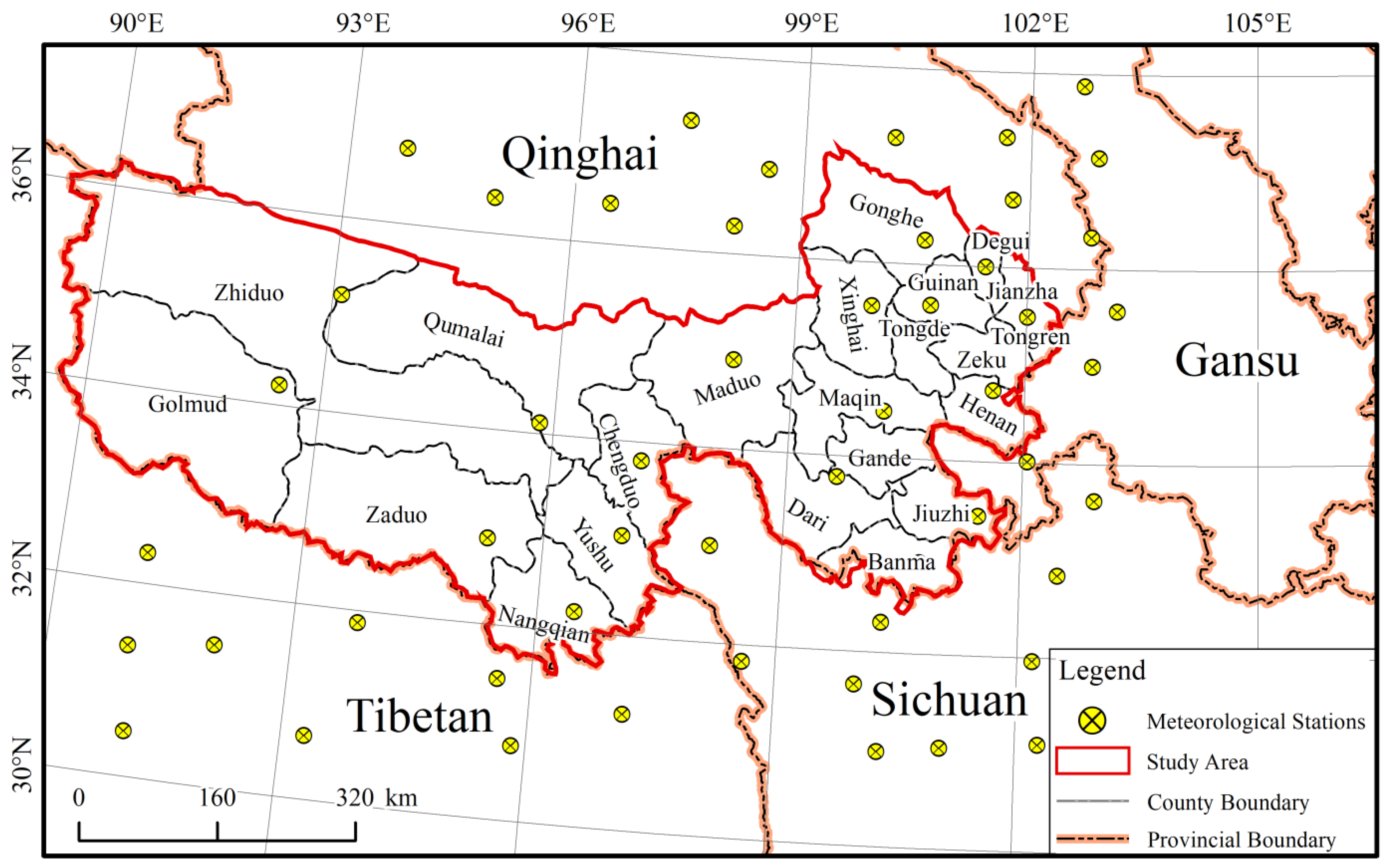



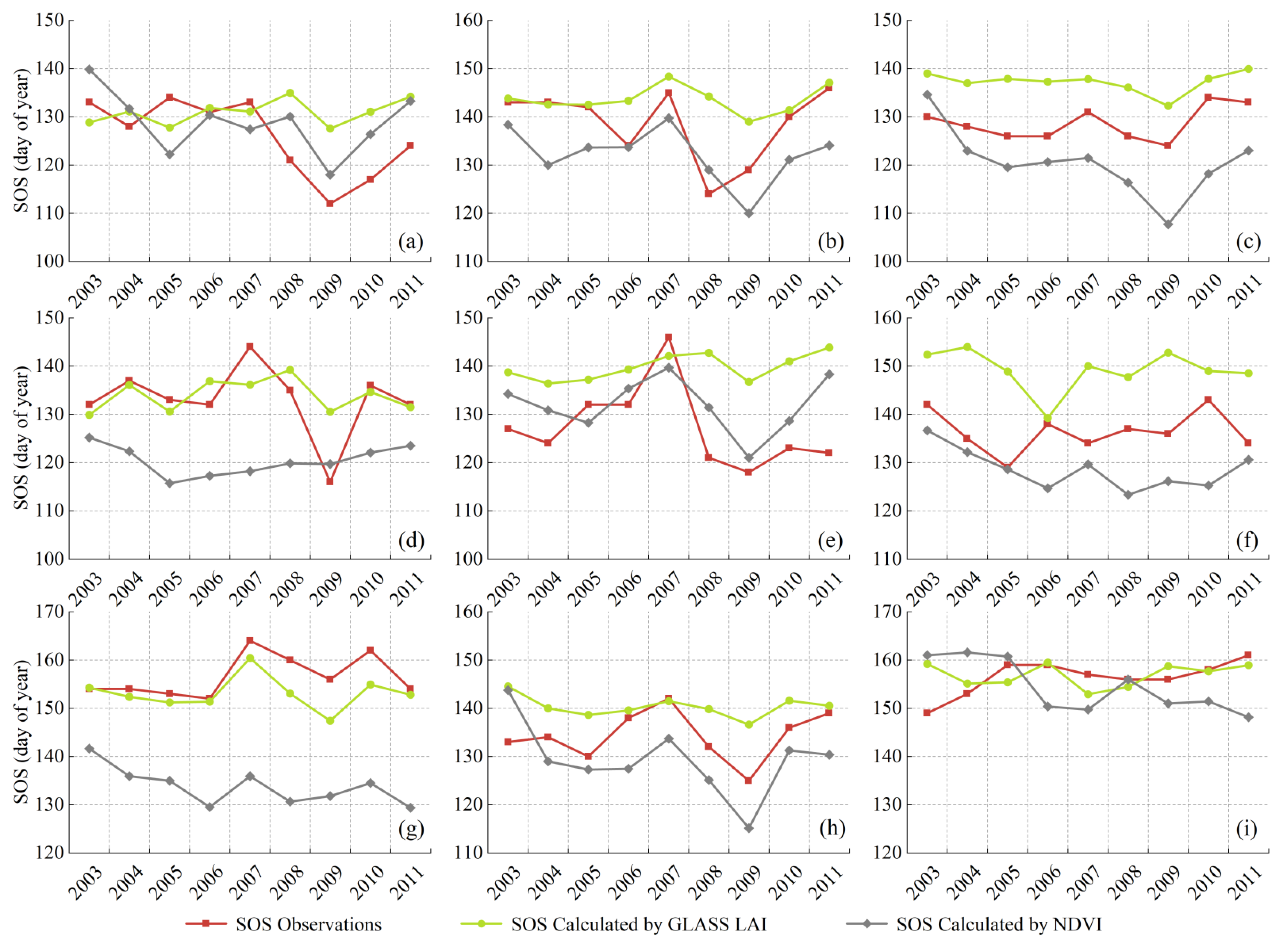
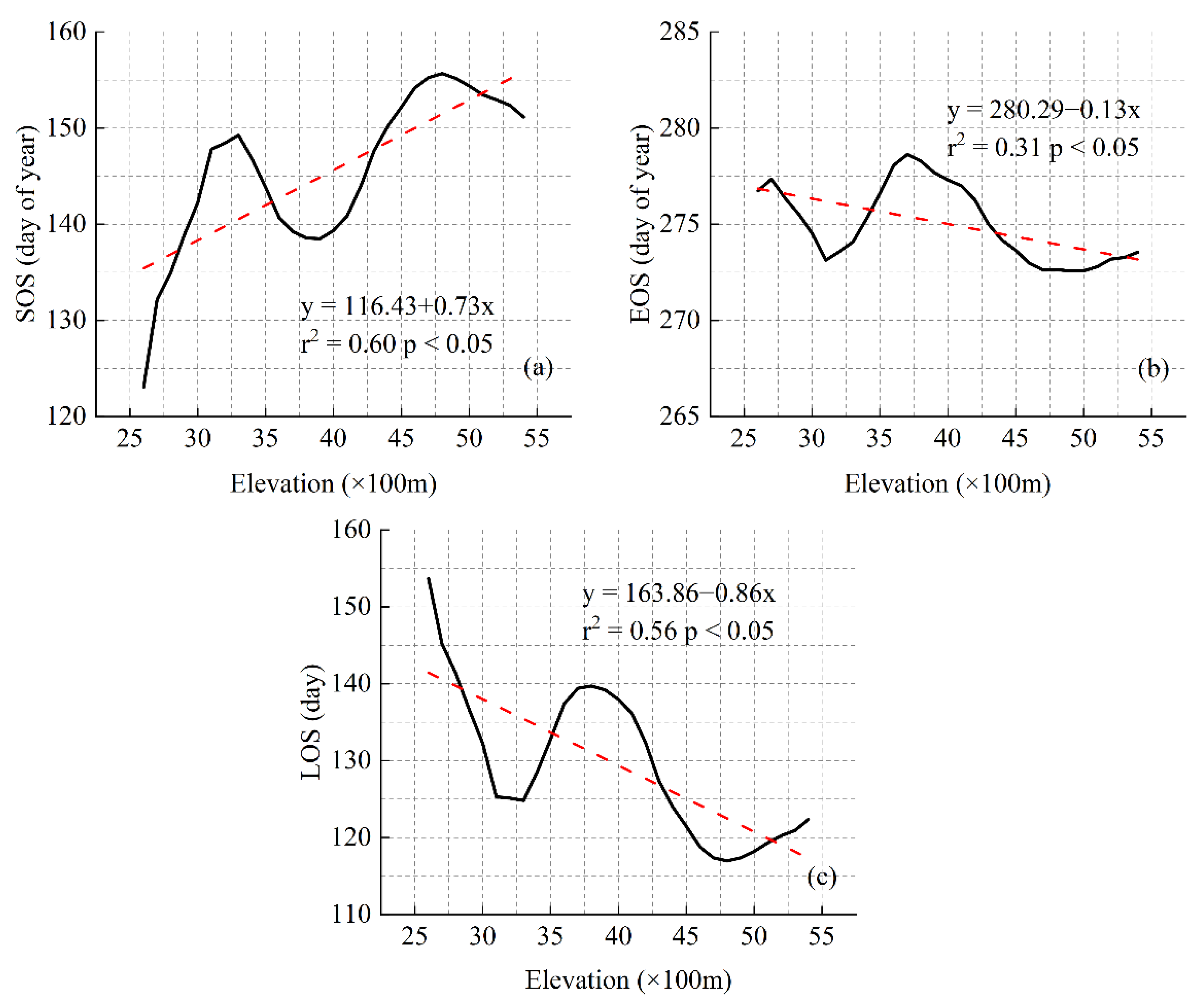

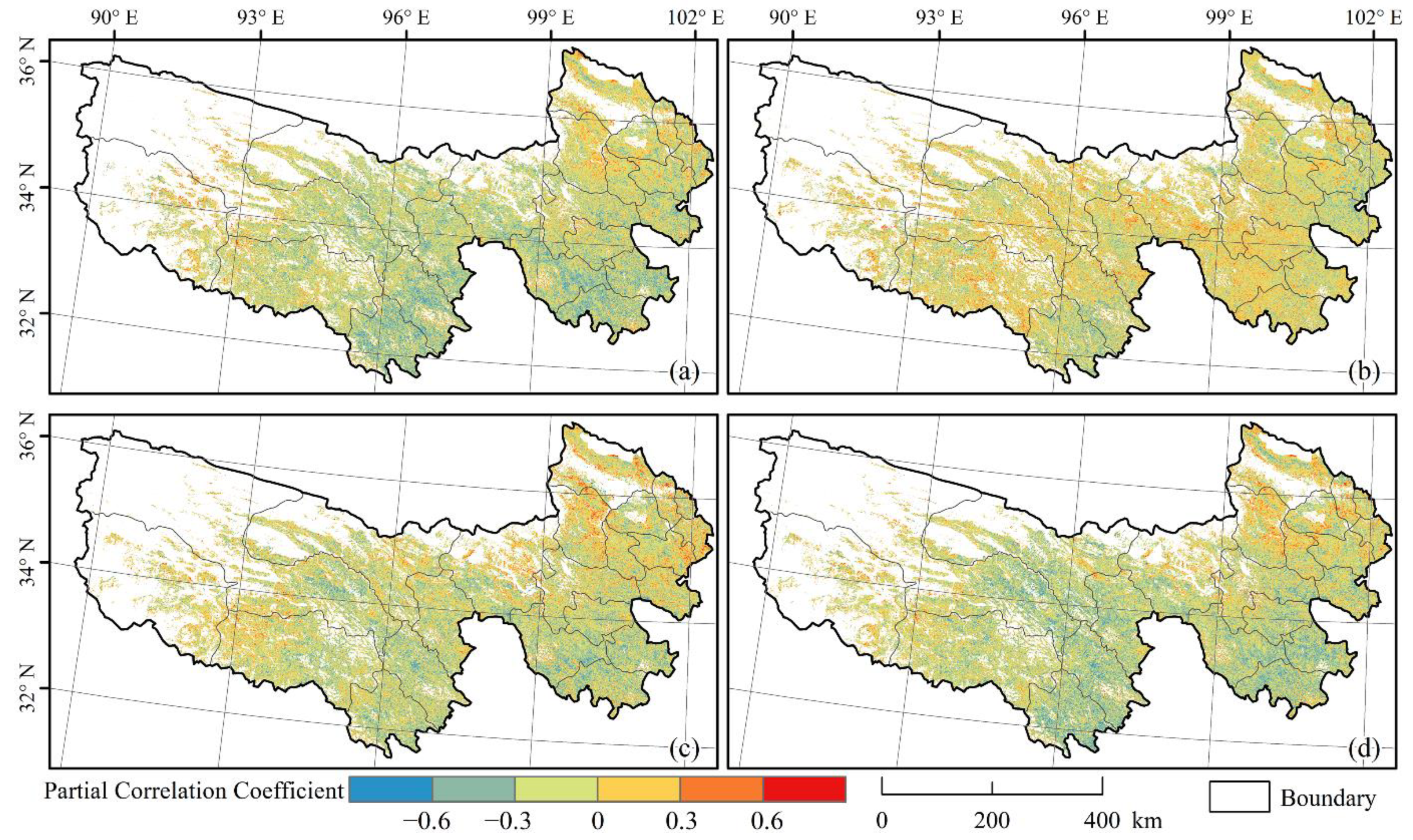

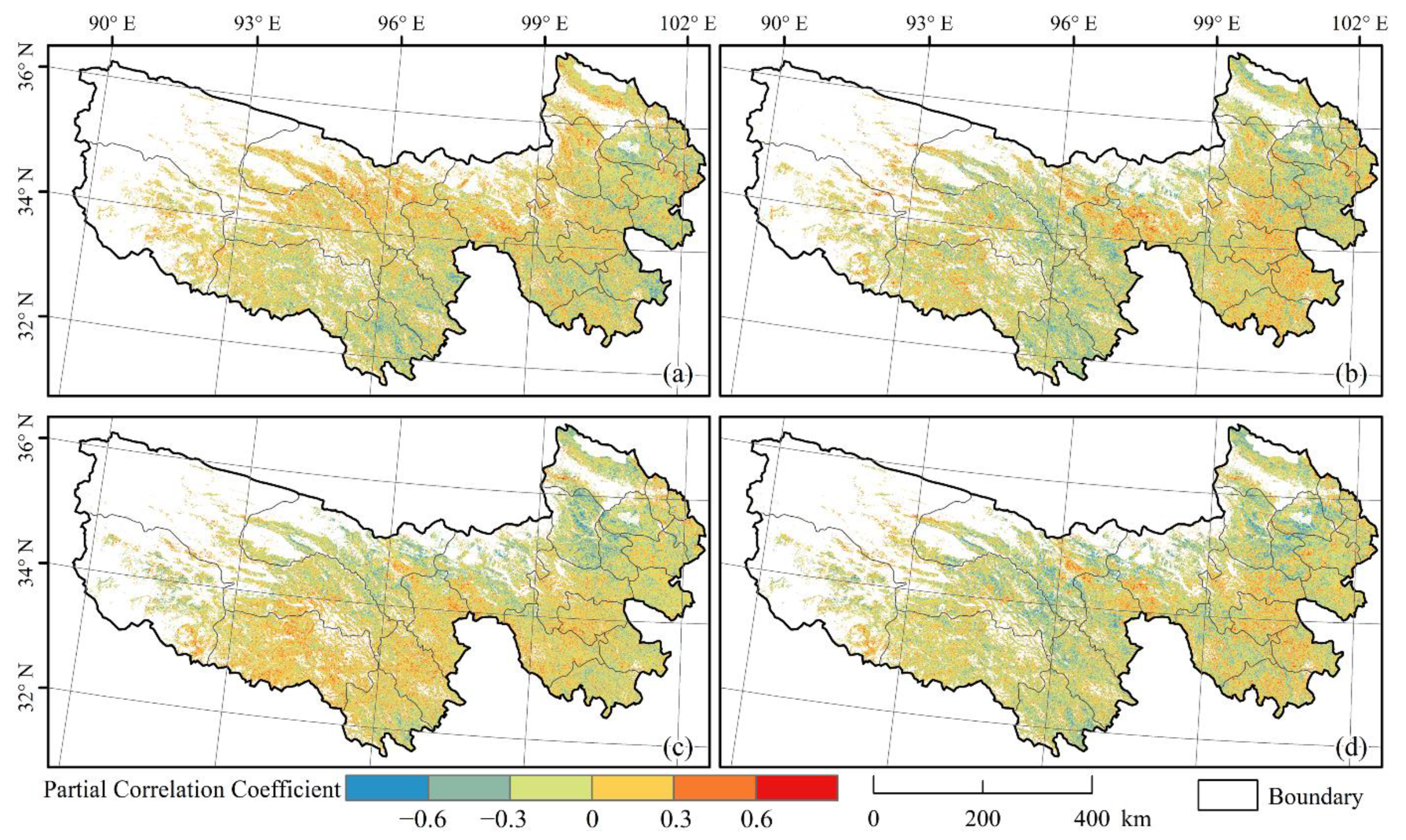
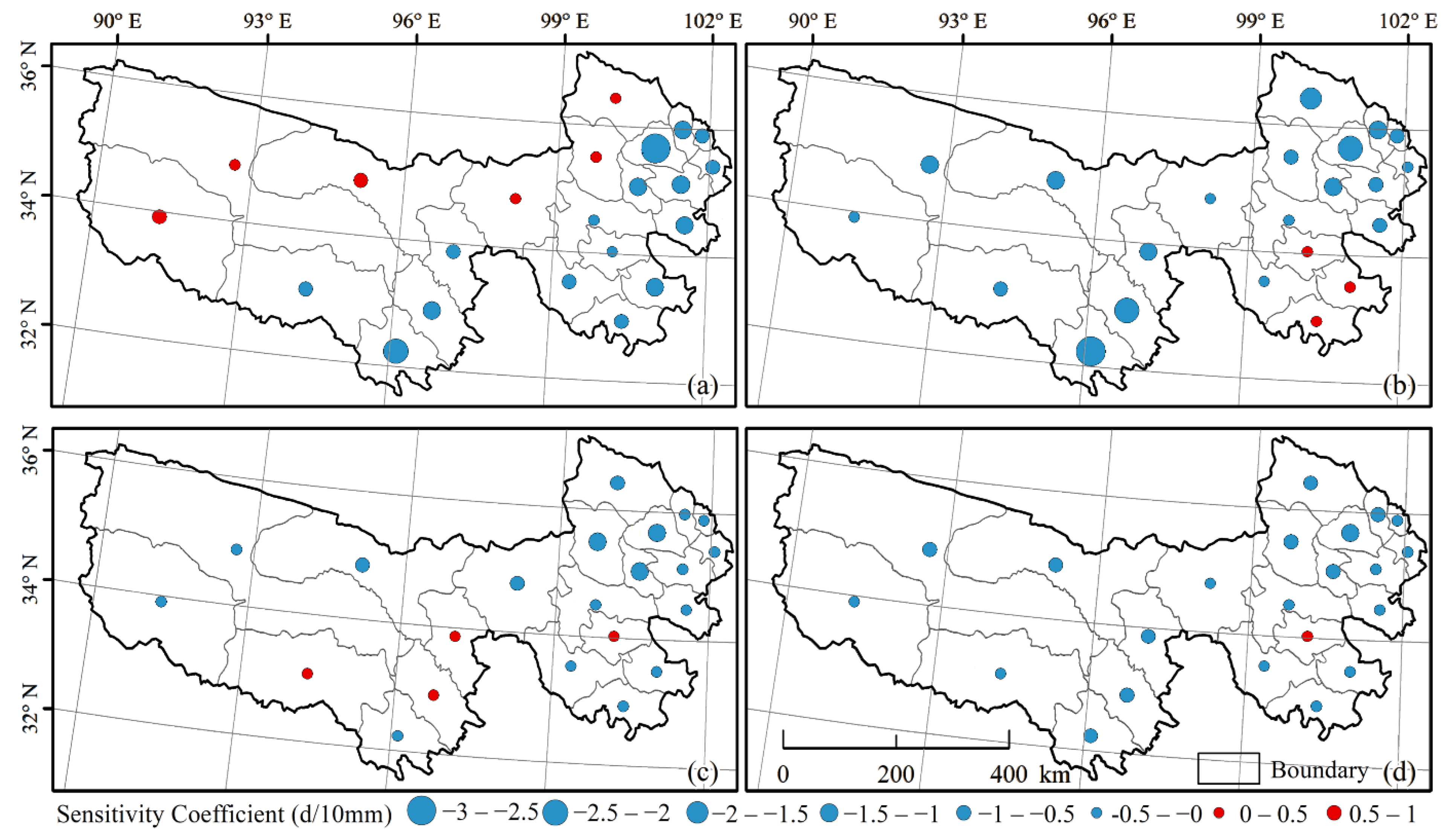



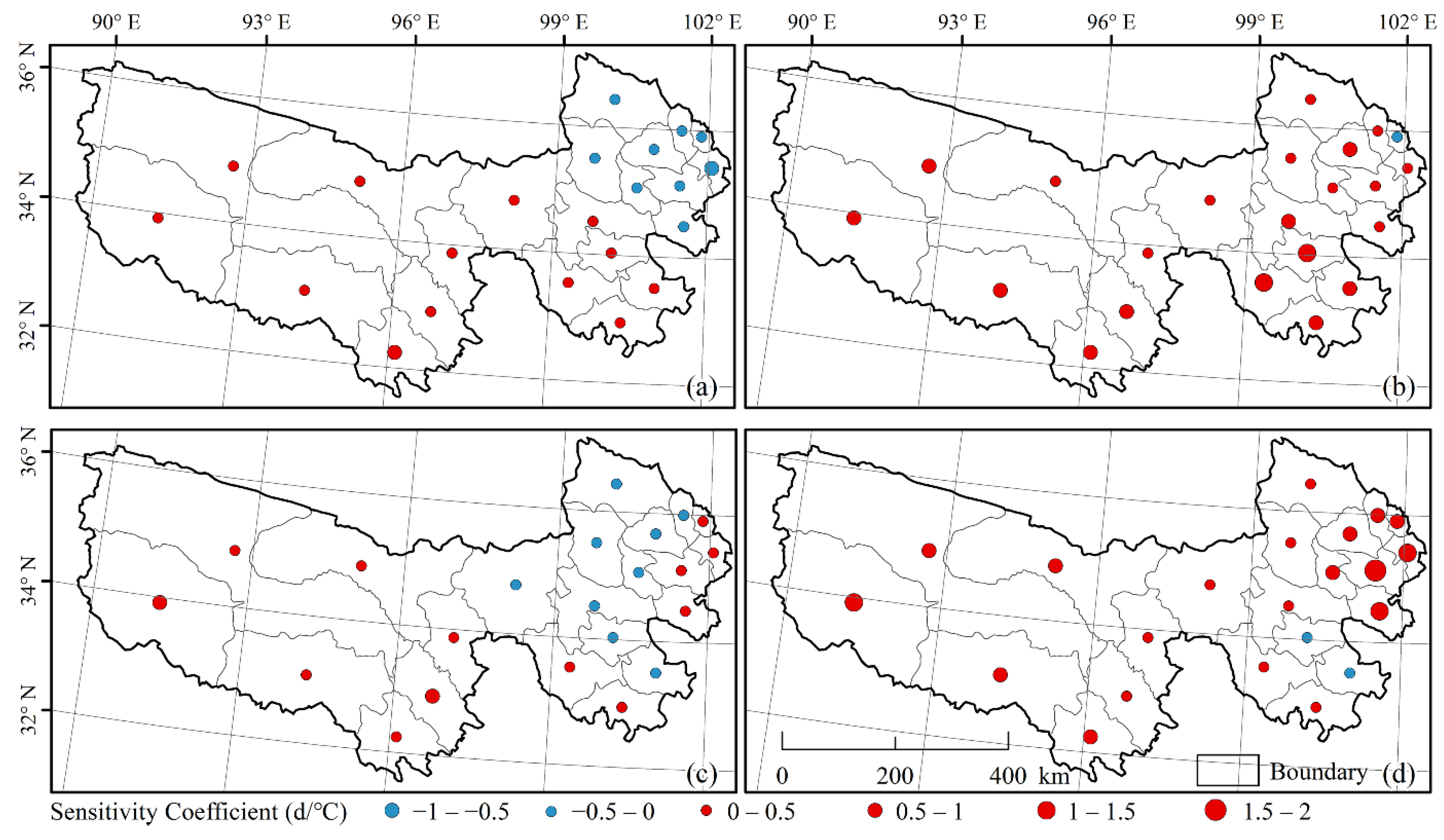
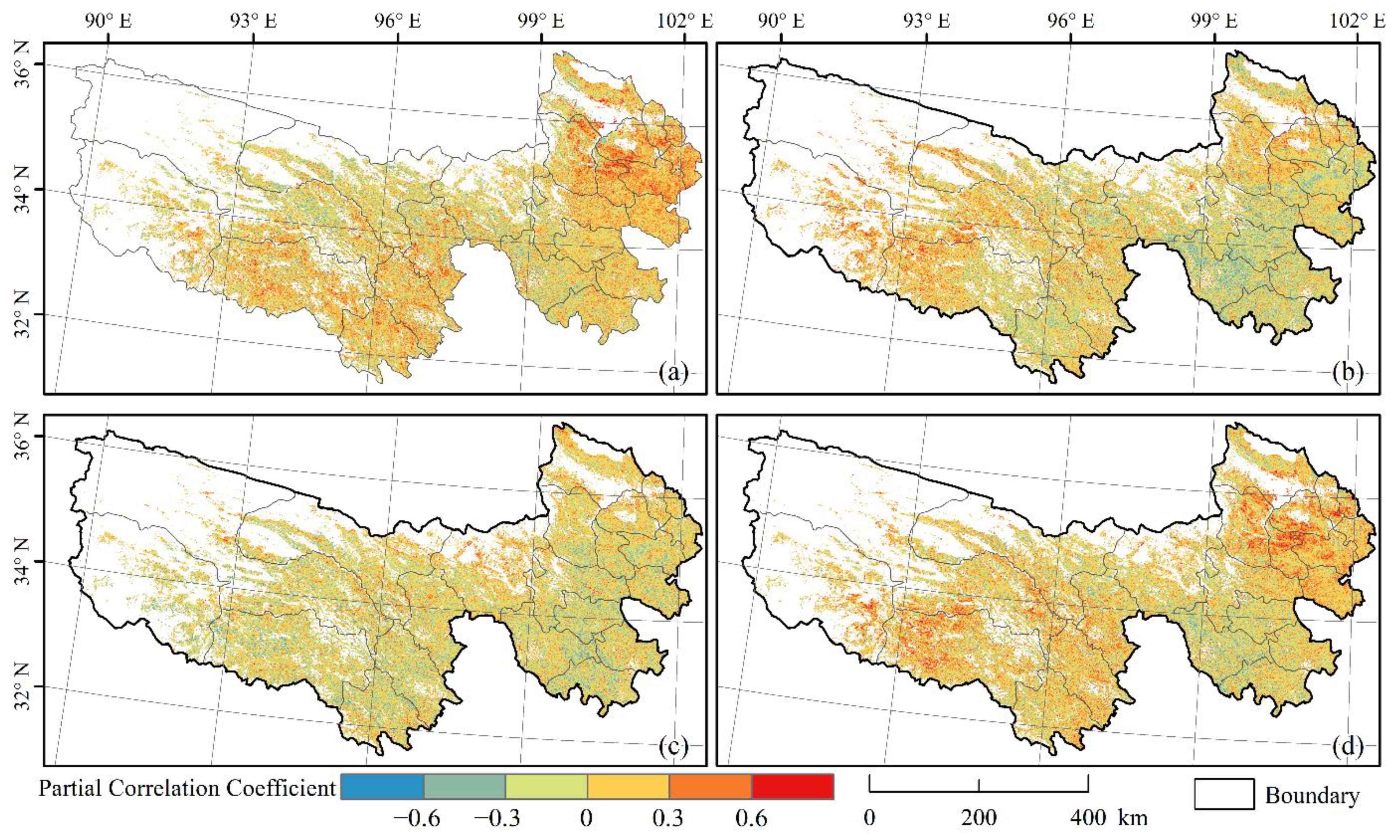
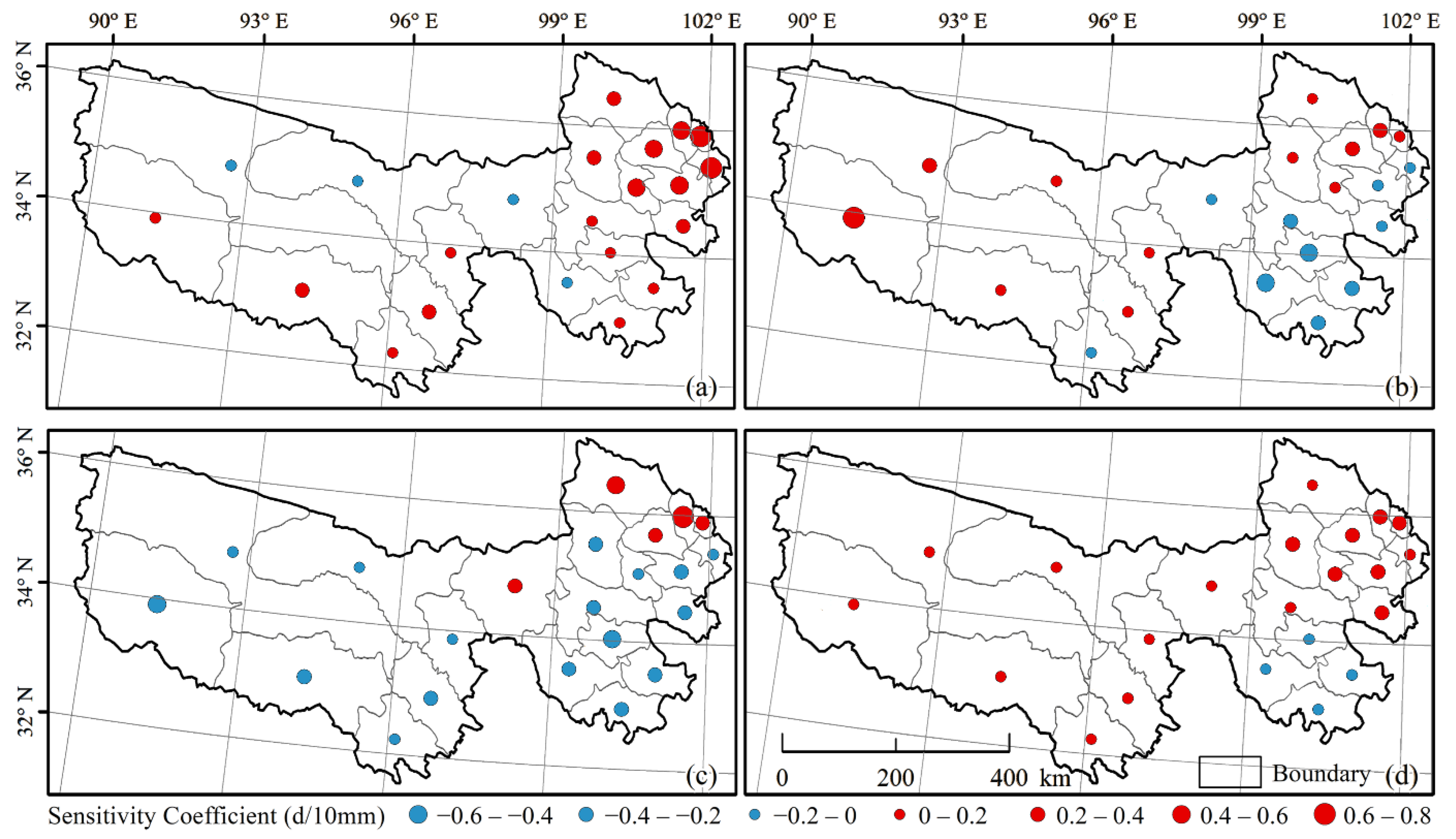
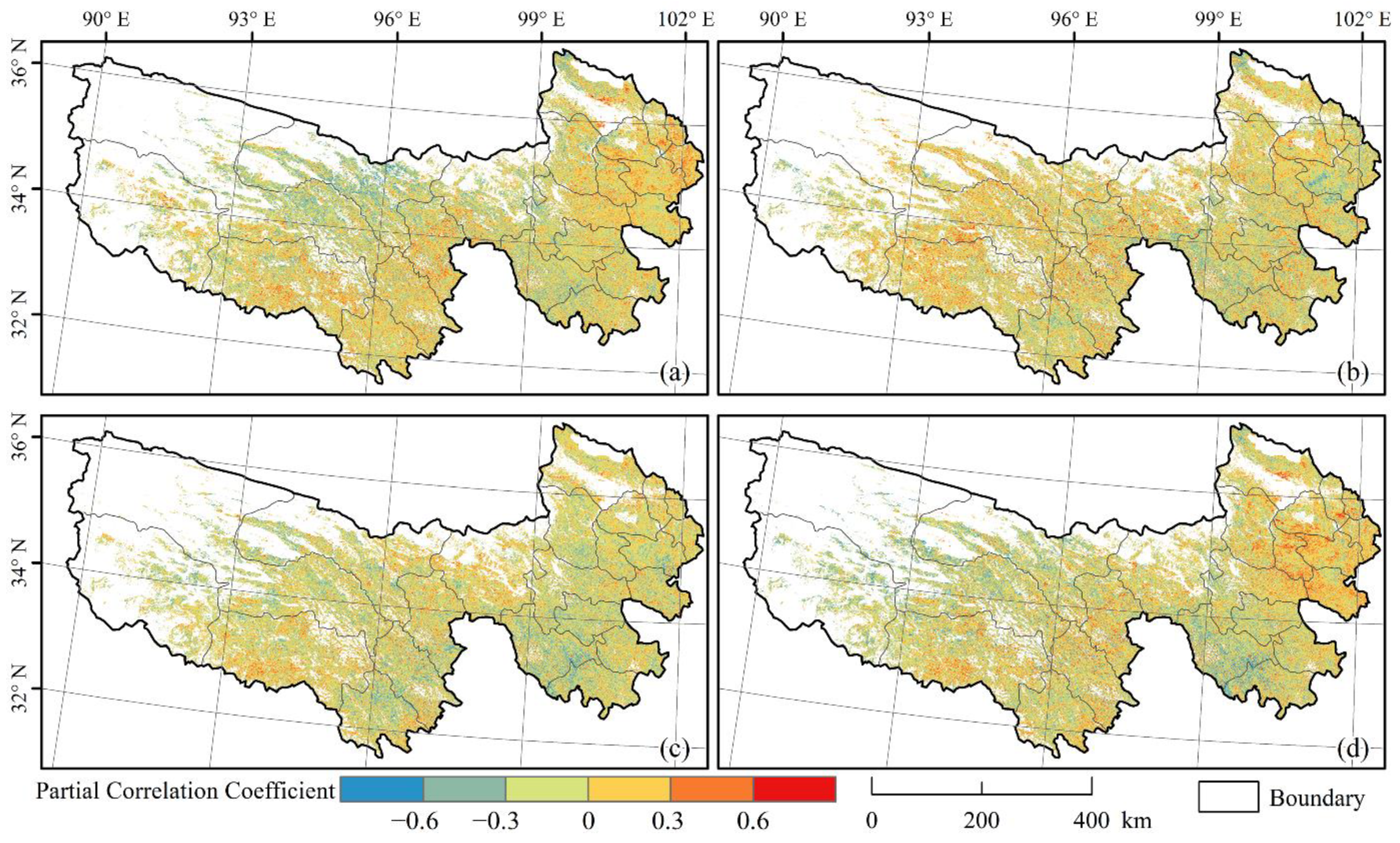

| Interannual Rate of Variation Classification (d/a) | Area Proportion (%) | Min of Interannual Variation Rate (d/a) | Max of Interannual Variation Rate (d/a) | |
|---|---|---|---|---|
| SOS | <−0.8 | 7.71 | −5.35 | 9.70 |
| −0.8–−0.4 | 19.77 | |||
| −0.4–0 | 47.84 | |||
| 0–0.4 | 17.5 | |||
| 0.4–0.8 | 5.63 | |||
| >0.8 | 1.55 | |||
| EOS | <−0.6 | 2.05 | −5.52 | 8.33 |
| −0.6–−0.3 | 9.71 | |||
| −0.3–0 | 31.9 | |||
| 0–0.3 | 39.76 | |||
| 0.3–0.6 | 13.98 | |||
| >0.6 | 2.60 | |||
| LOS | <−1.2 | 1.23 | −6.00 | 10.33 |
| −1.2–−0.6 | 5.46 | |||
| −0.6–0 | 33.72 | |||
| 0–0.6 | 37.00 | |||
| 0.6–1.2 | 17.95 | |||
| >1.2 | 4.64 |
| Data Set | Error Index | Station | ||||||||
|---|---|---|---|---|---|---|---|---|---|---|
| Banma | Gande | Mongolian Autonomous County of Henan | Jiuzhi | Maqin | Nangqian | Qingshuihe | Zeku | Tuotuohe | ||
| LAI | RMSE | 12.9 | 8.3 | 8.9 | 6.0 | 17.6 | 14.0 | 4.6 | 7.3 | 4.1 |
| MAE | 10.3 | 5.2 | 8.6 | 4.3 | 15.8 | 12.7 | 3.5 | 6.1 | 3.0 | |
| NDVI | RMSE | 7.6 | 8.3 | 10.1 | 14.7 | 8.0 | 9.7 | 23.4 | 7.9 | 8.0 |
| MAE | 6.9 | 7.4 | 9.2 | 13.4 | 7.0 | 7.9 | 22.7 | 7.5 | 7.0 | |
| Meteorological Factor | Positive Correlation | Significant Positive Correlation | Negative Correlation | Significant Negative Correlation |
|---|---|---|---|---|
| 26.58 | 0.65 | 73.42 | 8.92 | |
| 42.00 | 1.72 | 58.00 | 4.10 | |
| 32.85 | 1.23 | 67.15 | 6.39 | |
| 27.45 | 0.90 | 72.45 | 9.07 | |
| 42.10 | 1.72 | 57.90 | 4.10 | |
| 38.64 | 1.67 | 62.23 | 5.64 | |
| 41.46 | 1.48 | 58.54 | 4.13 | |
| 34.11 | 1.29 | 65.89 | 6.71 | |
| 49.16 | 2.24 | 50.84 | 2.55 | |
| 38.64 | 1.33 | 61.36 | 4.68 | |
| 52.81 | 2.50 | 47.19 | 1.61 | |
| 43.97 | 1.55 | 56.03 | 3.01 |
| Meteorological Factor | Positive Correlation | Significant Positive Correlation | Negative Correlation | Significant Negative Correlation |
|---|---|---|---|---|
| 56.86 | 3.58 | 43.14 | 1.78 | |
| 62.19 | 5.09 | 37.81 | 1.61 | |
| 56.55 | 3.68 | 43.45 | 2.09 | |
| 60.25 | 3.85 | 39.75 | 1.22 | |
| 58.67 | 5.29 | 41.33 | 2.01 | |
| 50.19 | 3.21 | 49.81 | 3.23 | |
| 44.69 | 1.69 | 55.31 | 3.45 | |
| 58.55 | 5.55 | 41.45 | 1.94 | |
| 42.50 | 2.25 | 57.50 | 5.22 | |
| 45.60 | 3.18 | 54.40 | 4.16 | |
| 37.50 | 1.53 | 62.50 | 5.23 | |
| 41.54 | 3.04 | 58.46 | 6.33 |
| Study Periods | Data Sources | SOS of Vegetation (DOY) | EOS of Vegetation (DOY) | LOS of Vegetation (Day) | References |
|---|---|---|---|---|---|
| 1999–2013 | SPOT-VGT NDVI (1 km) | 130–150 | —— | —— | Liu et al. [52] |
| 2000–2014 | MOD09Q1 NDVI (250 m) | 125–155 | 280–290 | 130–160 | Liu [53] |
| 2001–2018 | MOD13A1 NDVI (500 m) | 125–145 | 268–277 | —— | Sun [54] |
| 2001–2018 | GLASS LAI (500 m) | 125–150 | 269–284 | 115–165 | This paper |
Publisher’s Note: MDPI stays neutral with regard to jurisdictional claims in published maps and institutional affiliations. |
© 2022 by the authors. Licensee MDPI, Basel, Switzerland. This article is an open access article distributed under the terms and conditions of the Creative Commons Attribution (CC BY) license (https://creativecommons.org/licenses/by/4.0/).
Share and Cite
Dai, X.; Fan, W.; Shan, Y.; Gao, Y.; Liu, C.; Nie, R.; Zhang, D.; Li, W.; Zhang, L.; Sun, X.; et al. LAI-Based Phenological Changes and Climate Sensitivity Analysis in the Three-River Headwaters Region. Remote Sens. 2022, 14, 3748. https://doi.org/10.3390/rs14153748
Dai X, Fan W, Shan Y, Gao Y, Liu C, Nie R, Zhang D, Li W, Zhang L, Sun X, et al. LAI-Based Phenological Changes and Climate Sensitivity Analysis in the Three-River Headwaters Region. Remote Sensing. 2022; 14(15):3748. https://doi.org/10.3390/rs14153748
Chicago/Turabian StyleDai, Xiaoai, Wenjie Fan, Yunfeng Shan, Yu Gao, Chao Liu, Ruihua Nie, Donghui Zhang, Weile Li, Lifu Zhang, Xuejian Sun, and et al. 2022. "LAI-Based Phenological Changes and Climate Sensitivity Analysis in the Three-River Headwaters Region" Remote Sensing 14, no. 15: 3748. https://doi.org/10.3390/rs14153748
APA StyleDai, X., Fan, W., Shan, Y., Gao, Y., Liu, C., Nie, R., Zhang, D., Li, W., Zhang, L., Sun, X., Liu, T., Yang, Z., Fu, X., Ma, L., Liang, S., Wang, Y., & Lu, H. (2022). LAI-Based Phenological Changes and Climate Sensitivity Analysis in the Three-River Headwaters Region. Remote Sensing, 14(15), 3748. https://doi.org/10.3390/rs14153748










